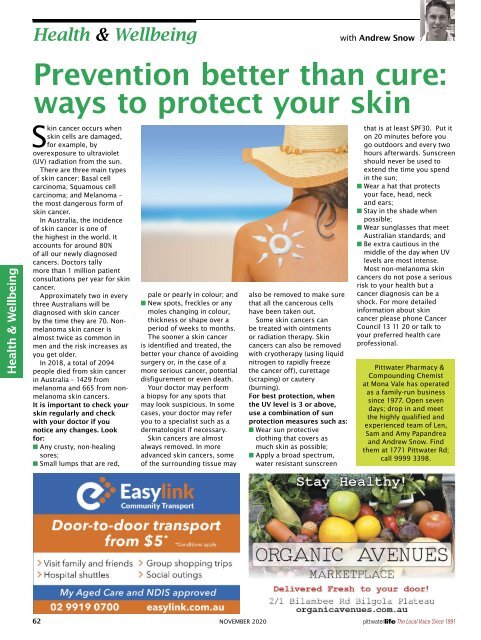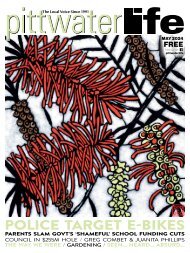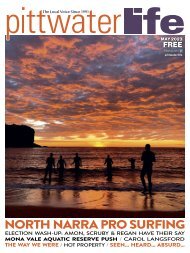Pittwater Life November 2020 Issue
FEARS FOR ‘COVID AMBASSADORS’ 1980 FLASHBACK: REMEMBERING THE FIRST AVALON VILLAGE FAIR SWELL CHASER: HOW TIM BONYTHON BECAME A BIG WAVE FILM MAKER LATEST COUNCIL NEWS / SUMMER SAILING / SEEN... HEARD... ABSURD...
FEARS FOR ‘COVID AMBASSADORS’
1980 FLASHBACK: REMEMBERING THE FIRST AVALON VILLAGE FAIR
SWELL CHASER: HOW TIM BONYTHON BECAME A BIG WAVE FILM MAKER
LATEST COUNCIL NEWS / SUMMER SAILING / SEEN... HEARD... ABSURD...
Create successful ePaper yourself
Turn your PDF publications into a flip-book with our unique Google optimized e-Paper software.
Health & Wellbeing<br />
with Andrew Snow<br />
Hair & Beauty<br />
with Sue Carroll<br />
Prevention better than cure:<br />
ways to protect your skin<br />
Summer’s here – it’s time to<br />
get your beauty ‘glow’ on<br />
Health & Wellbeing<br />
Skin cancer occurs when<br />
skin cells are damaged,<br />
for example, by<br />
overexposure to ultraviolet<br />
(UV) radiation from the sun.<br />
There are three main types<br />
of skin cancer: Basal cell<br />
carcinoma; Squamous cell<br />
carcinoma; and Melanoma –<br />
the most dangerous form of<br />
skin cancer.<br />
In Australia, the incidence<br />
of skin cancer is one of<br />
the highest in the world. It<br />
accounts for around 80%<br />
of all our newly diagnosed<br />
cancers. Doctors tally<br />
more than 1 million patient<br />
consultations per year for skin<br />
cancer.<br />
Approximately two in every<br />
three Australians will be<br />
diagnosed with skin cancer<br />
by the time they are 70. Nonmelanoma<br />
skin cancer is<br />
almost twice as common in<br />
men and the risk increases as<br />
you get older.<br />
In 2018, a total of 2094<br />
people died from skin cancer<br />
in Australia – 1429 from<br />
melanoma and 665 from nonmelanoma<br />
skin cancers.<br />
It is important to check your<br />
skin regularly and check<br />
with your doctor if you<br />
notice any changes. Look<br />
for:<br />
■ Any crusty, non-healing<br />
sores;<br />
■ Small lumps that are red,<br />
pale or pearly in colour; and<br />
■ New spots, freckles or any<br />
moles changing in colour,<br />
thickness or shape over a<br />
period of weeks to months.<br />
The sooner a skin cancer<br />
is identified and treated, the<br />
better your chance of avoiding<br />
surgery or, in the case of a<br />
more serious cancer, potential<br />
disfigurement or even death.<br />
Your doctor may perform<br />
a biopsy for any spots that<br />
may look suspicious. In some<br />
cases, your doctor may refer<br />
you to a specialist such as a<br />
dermatologist if necessary.<br />
Skin cancers are almost<br />
always removed. In more<br />
advanced skin cancers, some<br />
of the surrounding tissue may<br />
also be removed to make sure<br />
that all the cancerous cells<br />
have been taken out.<br />
Some skin cancers can<br />
be treated with ointments<br />
or radiation therapy. Skin<br />
cancers can also be removed<br />
with cryotherapy (using liquid<br />
nitrogen to rapidly freeze<br />
the cancer off), curettage<br />
(scraping) or cautery<br />
(burning).<br />
For best protection, when<br />
the UV level is 3 or above,<br />
use a combination of sun<br />
protection measures such as:<br />
■ Wear sun protective<br />
clothing that covers as<br />
much skin as possible;<br />
■ Apply a broad spectrum,<br />
water resistant sunscreen<br />
that is at least SPF30. Put it<br />
on 20 minutes before you<br />
go outdoors and every two<br />
hours afterwards. Sunscreen<br />
should never be used to<br />
extend the time you spend<br />
in the sun;<br />
■ Wear a hat that protects<br />
your face, head, neck<br />
and ears;<br />
■ Stay in the shade when<br />
possible;<br />
■ Wear sunglasses that meet<br />
Australian standards; and<br />
■ Be extra cautious in the<br />
middle of the day when UV<br />
levels are most intense.<br />
Most non-melanoma skin<br />
cancers do not pose a serious<br />
risk to your health but a<br />
cancer diagnosis can be a<br />
shock. For more detailed<br />
information about skin<br />
cancer please phone Cancer<br />
Council 13 11 20 or talk to<br />
your preferred health care<br />
professional.<br />
<strong>Pittwater</strong> Pharmacy &<br />
Compounding Chemist<br />
at Mona Vale has operated<br />
as a family-run business<br />
since 1977. Open seven<br />
days; drop in and meet<br />
the highly qualified and<br />
experienced team of Len,<br />
Sam and Amy Papandrea<br />
and Andrew Snow. Find<br />
them at 1771 <strong>Pittwater</strong> Rd;<br />
call 9999 3398.<br />
62 NOVEMBER <strong>2020</strong><br />
The Local Voice Since 1991<br />
Along with our great outdoor<br />
lifestyle comes the<br />
ravages of the Australian<br />
sun and hyperpigmentation<br />
in all its forms. With summer<br />
knocking at our door, there is<br />
still time to reduce last year’s<br />
brown spots before adding to<br />
those we will acquire this year.<br />
There are three main types<br />
of pigmentation: Epidermal,<br />
where the pigmentation is close<br />
to the surface of the skin and<br />
is light brown; Dermal, where<br />
the brown marks appear more<br />
solid, is usually deep brown<br />
and ashen grey; and a mixture,<br />
where both levels are usually<br />
dark brown.<br />
There are many causes of<br />
hyperpigmentation which may<br />
include: PIH (post-inflammatory<br />
hyperpigmentation; pregnancy<br />
(melasma); birth control pills;<br />
long-term sun exposure;<br />
estrogen (HRT); razor bumps;<br />
acne; severe sunburn; eczema;<br />
chemical irritations; rashes;<br />
abrasive scrubs; surgical<br />
procedures; perfume sprayed<br />
on sun-exposed skin; certain<br />
prescription medications; picking;<br />
insect bites; scratching;<br />
Chicken Pox; and trauma to the<br />
skin. They all lead to the same<br />
outcome where we have ageing<br />
brown marks on both our face<br />
and body.<br />
Melanocytes are cells in our<br />
skin that produce melanin, or<br />
pigment and these are located<br />
deep within the skin. It would<br />
be perfect if the colour or<br />
pigment was produced evenly<br />
across our skin but given the<br />
stimulants mentioned above<br />
aggravating our melanin, this is<br />
not usually the case.<br />
My philosophy for treating<br />
hyperpigmentation focuses on<br />
five main areas to help achieve<br />
a luminous, radiant glow for<br />
our skin. These are: Surface exfoliation;<br />
suppressing melanocyte<br />
activity; treatment; cellular<br />
repair and protection; and<br />
lightening and brightening.<br />
With the assistance of<br />
gauze, toning lotion and/or<br />
The Local Voice Since 1991<br />
surface exfoliation, skin cells<br />
are sloughed off, revealing a<br />
brighter complexion. Some of<br />
the key ingredients in these<br />
products are Retinaldehydes,<br />
Mandelic Acid, Flower Acids<br />
and AHAs and BHAs.<br />
To reduce existing hyperpigmentation,<br />
superior brightening<br />
agents in skin care products<br />
will include Daisy Flower<br />
Extract, Kojic Acid, L-Arbutin,<br />
Resveratrol and Niacinamide –<br />
all of which assist in reducing<br />
melanocyte activity. This in<br />
turn will improve skin clarity<br />
and even out the skin tone.<br />
Treatments to help reduce<br />
the appearance of hyperpigmentation<br />
may include progressive,<br />
mid-depth and deep<br />
peels; Intense Pulsed Light (IPL),<br />
Fractional Laser, Skin Classic<br />
Dyathermy, Nano Fractional<br />
Laser and Tixel, or a combination<br />
of these procedures.<br />
When our skin is under attack<br />
from any of the causes of<br />
hyperpigmentation, cellular<br />
breakdown occurs and cellular<br />
repair is needed. This can be in<br />
the form of internal nutritional<br />
food and supplements (including<br />
the antioxidants Vitamins<br />
A, B and C) and external product<br />
application (which include<br />
ingredients such as reparative<br />
stem cells like Gardenia, Swiss<br />
Apple, Edelweiss, Vitamin C<br />
and B). By incorporating a natural<br />
physical sunscreen – zinc<br />
and titanium dioxide – to our<br />
everyday skincare regime, the<br />
skin has a natural shield of protection<br />
against future attacks. It<br />
is important to note regular 3-4<br />
hourly application of sunscreen<br />
is required; and even then we<br />
can still obtain a tan.<br />
To assist with lightening and<br />
brightening our complexion,<br />
the skin may benefit from the<br />
infusion of Vitamin C, Mandelic<br />
and Phytic Acids, and Plantain<br />
Leaf extract. In-clinic skincare<br />
treatments are like the ‘boot<br />
camp’ for the infusion process –<br />
and it does not mean you have<br />
to suffer to be glowing. The<br />
treatments are performed regularly<br />
and provide radiant skin<br />
and you leaving more relaxed –<br />
a great prescription for healthy,<br />
radiant skin.<br />
We live in “a sunburnt country”,<br />
so we need to be vigilant<br />
year-round with our skin/sun<br />
protection. A healthy diet for<br />
internal support and sun protection<br />
(sunglasses, sunscreen,<br />
sun hat, long sleeves) and<br />
skincare supporting cellular<br />
repair and melanin suppression<br />
will all assist with the necessary<br />
external support. The result will<br />
allow us to ‘get our glow on’.<br />
Sue Carroll is at the forefront<br />
of the beauty, wellness<br />
and para-medical profession<br />
with 35 years’ experience on<br />
Sydney’s Northern Beaches.<br />
She leads an experienced,<br />
professional team who are<br />
passionate about results for<br />
men and women.<br />
info@skininspiration.com.au<br />
www.skininspiration.com.au<br />
NOVEMBER <strong>2020</strong> 63<br />
Health Hair & Wellbeing Beauty

















